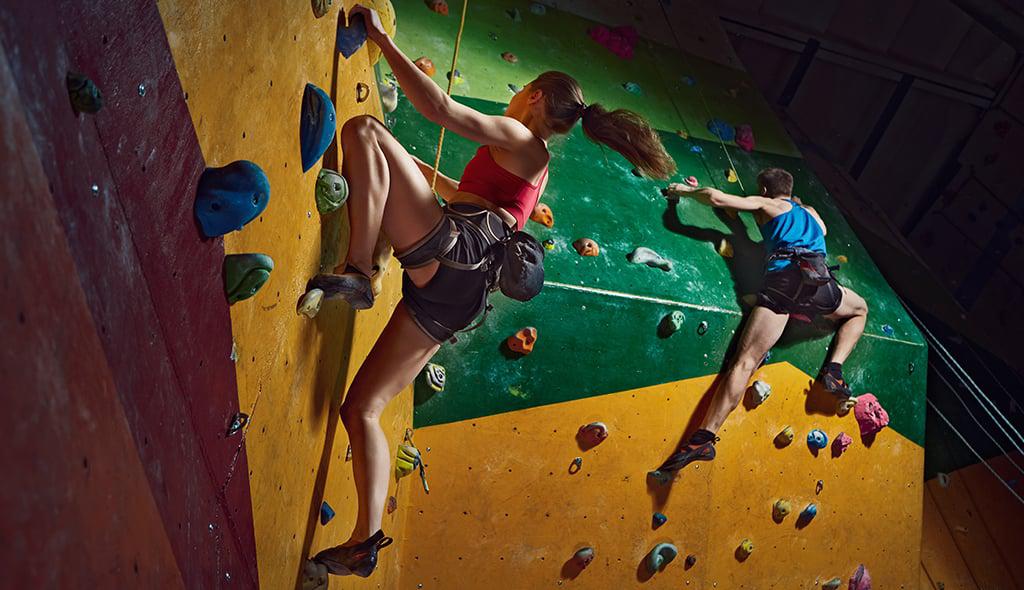Yes, rock climbing can be challenging for beginners. However, with proper training and guidance, anyone can learn the necessary skills to become a successful climber.
Rock climbing is a sport that involves using hands, feet, and other body parts to climb rocks, mountains, and cliffs. For beginners, this can be a daunting task, as the sport requires a combination of strength, technique, endurance, and mental fortitude.
However, despite its challenges, rock climbing is a rewarding and exhilarating activity that can be enjoyed by anyone willing to put in the time and effort to learn. With the right training, gear, and mindset, beginners can overcome their initial fears and begin to explore the world of rock climbing. In this article, we will explore the difficulties that beginners may face in rock climbing and offer tips on how to overcome them.

Credit: www.nytimes.com
Understanding The Basics Of Rock Climbing
Rock climbing can seem like a daunting sport to beginners, but with patience and practice, anyone can learn to climb. Before hitting the walls, it’s essential to grasp the basics of rock climbing, which includes understanding the necessary equipment and gear, the different climbing techniques, and the importance of proper instruction and guidance.
Explanation Of The Necessary Equipment And Gear For Rock Climbing
Rock climbing, like any other sport, requires specific gear to ensure safety and comfort during climbs. Here are some of the essential equipment that every beginner needs to get started:
- Ropes: Climbing ropes are strong and durable, designed to withstand the weight and movement of climbers.
- Harnesses: A harness is a belt-like device worn around the waist and thighs to keep the climber secure.
- Climbing shoes: These specialized shoes are designed to provide a better grip on the rock surface.
- Chalk and chalk bags: Chalk is essential for keeping hands dry and providing a better grip on the rock.
- Helmets: A helmet provides protection against falling objects and accidental falls.
- Carabiners and quickdraws: These tools are used to attach climbers to the ropes and the rock surface.
Introduction To Different Climbing Techniques
Different types of climbing techniques are used by climbers, depending on the surface they’re climbing and their skill level. Here are the most common types of climbing techniques:
- Bouldering: A style of climbing that involves scaling small rock formations or boulders without ropes. Bouldering is usually done close to the ground and requires a lot of strength and agility.
- Sport climbing: Sport climbing involves climbing a pre-set route or path, using bolts and anchors to secure the rope and progress through the climb.
- Traditional climbing: Also known as trad climbing, it involves placing gear in cracks and other features in the rock surface to protect the climbers and provide anchors for the ropes.
- Free soloing: This is the most dangerous form of climbing and involves ascending the rock surface without any gear or protection.
Bouldering Vs Sport Climbing
Bouldering and sport climbing are two of the most popular forms of rock climbing. While there are similarities between the two, there are also some significant differences.
- Bouldering is usually done near the ground, while sport climbing is done on higher surfaces.
- Bouldering relies on strength and agility and involves shorter, more challenging climbs. In contrast, sport climbing involves longer climbs that require endurance and technique.
- Bouldering requires less gear and equipment than sport climbing, making it an affordable option for beginners.
Indoor Climbing Vs Outdoor Climbing
Indoor climbing and outdoor climbing offer different experiences, and each has its own set of challenges. Indoor climbing is done on artificial walls, typically in climbing gyms. It’s an excellent way to practice and learn new climbing techniques in a controlled environment.
Outdoor climbing, on the other hand, allows climbers to experience the thrill of climbing natural rock formations, often in beautiful, remote settings. Outdoor climbing requires more preparation and gear, and beginners are advised to seek guidance from experienced climbers.
Emphasize The Importance Of Proper Instruction And Guidance For Beginners
Rock climbing can be a dangerous sport, and beginners are advised to seek proper instruction and guidance before embarking on climbs. Proper instruction can help climbers learn essential techniques, gain confidence, and avoid accidents. Climbers are encouraged to join a gym or club to learn from experienced climbers and take courses on climbing safety and techniques.
Understanding the basics of rock climbing is essential for beginners looking to master the sport. By focusing on the necessary equipment and gear, different climbing techniques, and the importance of proper instruction and guidance, beginners can progress to more challenging climbs with confidence and safety.
So gear up, find a climbing gym or experienced climber, and start climbing!
Challenges Faced By Beginners In Rock Climbing
Rock climbing is a challenging and thrilling sport that requires both physical and mental strength, endurance, and focus. It can be a rewarding experience for beginners but often comes with various obstacles and risks. We discuss the challenges faced by beginners in rock climbing, including the physical and mental demands, overcoming fears, potential risks and dangers, and real-life experiences of climbing for beginners.
Discussion Of The Physical And Mental Demands Of Rock Climbing For Beginners
Rock climbing is an intense physical and mental activity that requires significant stamina, strength, and endurance. Here are some specific demands that beginners may face when starting rock climbing:
- Grip strength and finger dexterity to hold onto rocks and handles.
- Upper-body strength and endurance to pull and push the bodyweight.
- Core strength to maintain balance, stability, and control the body position.
- Flexibility to move easily and efficiently through various situations.
- Mental focus and discipline to stay calm and in control while climbing.
Stamina, Strength, And Endurance Required
Rock climbing is a physically demanding sport that requires long hours of practice and training to develop endurance, strength, and stamina. Here are some ways in which beginners can improve their stamina, strength, and endurance:
- Regular exercises such as cardio, strength training, and core exercises to build strength and endurance.
- Climbing practice to develop muscular and cardiovascular endurance, as well as grip strength and dexterity.
- Stretching and mobility exercises to improve flexibility and prevent injuries.
Overcoming Fear Of Heights And Trusting The Gear
One of the most significant challenges beginners face in rock climbing is fear of heights. The heights and exposure of climbing can induce an intense fear response in some people. Here are some tips and strategies for beginners to overcome the fear of heights and trust the gear:
- Gradual exposure to height by climbing routes with lower elevations or bouldering.
- Building trust in the gear by carefully inspecting and testing the equipment before climbing.
- Breathing and visualization techniques to manage anxiety and stay calm while climbing.
Highlight The Potential Risks And Dangers Of Rock Climbing As A Beginner
Rock climbing can be a risky and dangerous activity, especially for beginners who are not aware of the potential risks and hazards. Here are some of the risks and dangers that beginners may face when climbing:
- Injuries such as cuts, bruises, sprains, and fractures from falls, slips, or accidents.
- Dehydration and exhaustion due to prolonged physical exertion and exposure to sunlight.
- Hypothermia and frostbite from exposure to cold weather conditions.
- Rope-related accidents such as equipment failure, rappelling accidents, and belaying errors.
Injuries, Accidents, And Falls
Like any other physically involved athletic activity, rock climbing can sometimes result in serious injuries that might take months or even years to recover from. Beginners are especially vulnerable to accidents and falls due to a lack of experience and skill.
Here are some common types of injuries and accidents that climbers may suffer:
- Sprains, strains, and bruises from slips, falls, or improper hand and foot placement.
- Dislocations and fractures from the sudden impact of falls or accidents.
- Head injuries such as concussions from hitting against rocks or other objects.
- Climbing equipment failure, such as broken gear or incorrect usage of ropes and belaying devices.
Real-Life Experiences Of Beginners And Their Challenges
Beginners often face various challenges when learning to climb. Personal experiences and anecdotes can provide insight into common challenges and how they can be overcome. Here are some examples of real-life experiences of beginner climbers:
- Julie, a beginner climber, found it challenging to overcome her fear of heights when climbing routes with high exposure. She overcame her fear by practicing breathing exercises and gradually increasing her altitude limit over time.
- Mark, a beginner climber, struggled with grip strength and found it challenging to hold onto rocks and handles. He improved his grip strength through grip exercises and regular climbing practice.
- Sarah, a beginner climber, suffered a knee injury from a fall when climbing a challenging route. She took a break from climbing and focused on recovery and rehabilitation before returning to climbing.
Rock climbing can be a demanding and challenging sport for beginners. However, with proper training, practice, and preparation, beginners can overcome obstacles, improve their skills, and achieve their goals.
Frequently Asked Questions On Is Rock Climbing Hard For Beginners?
Is Rock Climbing A Good Workout For Beginners?
Yes, rock climbing is a great full-body workout for beginners. It builds strength and endurance while also improving balance and flexibility.
What Equipment Do Beginners Need For Rock Climbing?
Beginner climbers will need a harness, climbing shoes, a chalk bag, a helmet, and a belay device. It’s also important to have a climbing rope and anchor system for outdoor climbing.
Can Beginners Rock Climb Without Any Experience?
Yes, many climbing gyms offer beginner classes and have staff to teach basic techniques and safety protocols. Outdoor climbing should be done with an experienced climber or guide.
Conclusion
As a beginner, rock climbing can seem like an intimidating sport. But the truth is, with the right mentality, equipment, and training, anyone can become a confident climber. Don’t let fear hold you back from experiencing the thrill of reaching the top of a challenging climb, or the sense of accomplishment that comes with conquering a difficult route.
Take your time to learn proper techniques and safety precautions, and push yourself gradually to improve your skills. Find a supportive community, whether it’s through a climbing gym or outdoor group, to offer encouragement and advice as you progress. With perseverance and dedication, you’ll be surprised at how quickly you can advance from a beginner to intermediate climber.
So take that first step and give rock climbing a try – you never know where it might take you.




